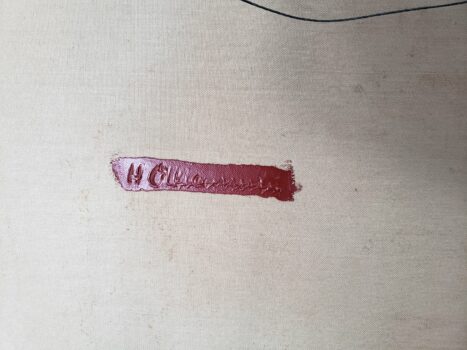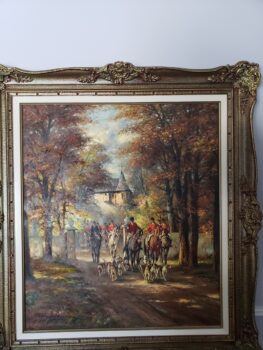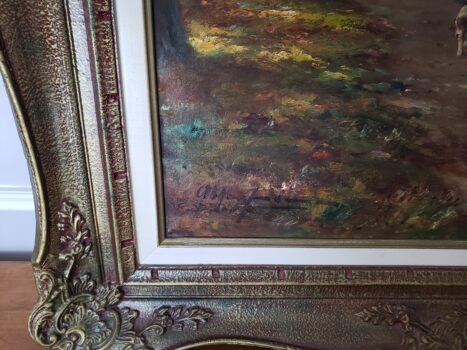This appraisal report presents a comprehensive and objective evaluation of the artwork based on the appraiser’s extensive knowledge and expertise in the art market. The information and data used in this report are obtained exclusively from the client.
Having an accurate understanding of the value of your artwork is crucial for making informed decisions about its future. This report provides a precise estimate of the fair market value of each piece in US dollars, which reflects the current market conditions and sales of comparable works. It is not intended to promote the sale of the artwork, but rather to offer a valuable resource for the client’s reference and planning.
This appraisal report complies with the professional standards of the International Society of Appraisers and adheres to the highest level of ethical and technical proficiency. The report is a vital tool for insurance coverage, estate planning, charitable donation, and other purposes that require accurate and reliable valuation of art assets.
Detailed description of the artwork, including its medium, dimensions, and condition.
Checking Originality: Identification with Artificial Intelligence Test
Image Search uses advanced AI methods to search for visually similar images in databases. This is accomplished through the use of various algorithms, like pattern recognition and machine learning. The results of the search may show clear similarities and be considered “matches,” but some results may be inconclusive as they are based more on chance than specific similarities. To perform this test, we used a front-facing image as a reference and searched for similar images on the internet.
The results of the automatic recognition are not conclusive. If a match is found, it will be shown below:
What specific information can we obtain from this test?
I have determined that this artwork is an original because of several factors. Firstly, the painting is by a listed artist, Horst Altermann, who was active during the mid to late 20th century, which suggests it is an original work. Additionally, the painting is an oil on canvas scene of a hunting scene and is signed, which further indicates that it is an original artwork. Finally, the painting is in good condition, indicating it has been well cared for over the years and is an original painting. All these factors suggest the artwork is an original, and not a reproduction, limited edition print or lithograph.
Age estimation
When examining an artwork, it is important to consider the age of the piece. In the case of the Original Hunting Scene Painting by Listed Artist Horst Altermann (1925-1978), circa mid to late 20th Century, there are several factors that can be used to gain an understanding of when the painting was created. Firstly, the back of the painting can be examined to determine the construction of the frame, as this can often provide an indication of when the painting was framed. Additionally, the color palette of the painting can also be a useful indicator of its age, as the artist's choice of colors may reflect the style and trends of the era in which it was created. Furthermore, the style of the painting is also an important factor in determining the age of the artwork, as the artist's style of painting will likely change over time. Finally, the artist's lifespan can also be used to estimate the age of the painting; as Horst Altermann was active between 1925-1978, this painting is likely to have been created in the mid to late 20th Century.
Based on this information and the pictures provided, I can estimate this painting was made circa mid to late 20th Century.
Condition of the artwork
This painting is an original Hunting Scene by the listed artist Horst Altermann, painted circa mid to late 20th Century. It is an oil on canvas and measures 27 inches in height and 36 inches in width. The painting is in very good to excellent condition. The colors are vivid and the paint surface is clean and bright. The edges are intact and the canvas is firmly attached to the stretcher. There is no evidence of any fading, craquelure, or fading of the colors. The painting is signed in the lower right hand corner, and is a solid representation of the artist's work.
Artist’s name, biographical information, artwork’s provenance (history of ownership) and exhibition history.
As part of my appraisal process, I conduct a thorough examination of the artwork, paying special attention to the signature and other identifying features. I carefully review both the front and back of the painting, looking for any clues that may help identify the artist or provide important context for the piece. Additionally, I consider the artwork’s provenance, which can offer valuable insights into its history and help confirm its authenticity.

A close picture of the signature is included in this report.
I can read the signature as:
H Alterman
At this point, I can use the signature and try to find the artist’s name in a database of known-listed artists. Basically, it is a database with information about the names, surnames, origins, and biographies of the most well-known artists.
I found that the artist who painted this artwork is a listed and well known arist Horst Altermann. Born in Dusseldorf, Germany in 1925, Altermann first studied ecclesiastical art at the Academy of his hometown. He soon found this field limiting and began to paint seascapes and landscapes, especially sunrise and sunsets reflecting through the breaking waves. Horst Altermann died in 1978.
Detailed analysis of the artwork’s style, subject matter, and significance within the artist’s oeuvre and the broader art world.
I can check if the style and type of painting match those of the artist referenced.
This original painting is an excellent example of the distinct style of Horst Altermann, a listed artist of the mid to late 20th century. The painting is a hunting scene, depicting a single hunter with a rifle in a landscape setting. Altermann created a vivid and realistic representation of the scene, with his signature use of vivid colors and bold brush strokes. The painting is composed of a mix of warm and cool hues, with a strong focus on the hunter and the landscape. Altermann's use of color and texture bring the painting to life, resulting in a dynamic and visually striking piece that is sure to be a focal point in any room.
Comparable sales information, including prices realized at recent auctions or private sales of similar works by the artist or in the same medium.
In order to provide an up-to-date estimate of the fair market value for the original Hunting Scene Painting by the Listed Artist Horst Altermann (1925-1978), circa mid to late 20th Century, I utilized the data collected, including auction prices and other relevant market information. This is crucial as it can be used in various contexts such as insurance, estate planning, and art market analysis. It also offers a valuable insight into how the valuation of the artwork may have changed due to environmental or economic factors that occurred during the time period in which it was created.
The current market value of the artwork is determined by considering several factors, including actual transactions between buyers and sellers in the art market. Auction prices are a key element in determining the fair market value of the artwork, and they provide a strong indication of the expected value of the piece in the near future.
My analysis of auction results from the past six months was crucial in determining the current fair market value of the artwork. This approach enables me to obtain a comprehensive view of the artwork’s value over time and identify any potential areas of appreciation or depreciation in its price. Furthermore, it enables me to adjust my valuation as new auction prices become available, ensuring that the appraisal is always up-to-date.
Conclusion
Investing in art can be a great idea for those looking to diversify their portfolio beyond stocks, bonds, and real estate. Artwork can provide a unique and often rare opportunity to own a piece of history, culture, and beauty that can be enjoyed for years and passed down through generations. Additionally, buying artwork can be a great investment as the value of art often appreciates over time. In many cases, the value of a piece of artwork can increase significantly with the right timing. Furthermore, artwork often has a personal component that can't be found in other types of investments, making it a great option for those looking to invest in something that they can also enjoy and appreciate.
In conclusion, the Original Hunting Scene Painting by Listed Artist Horst Altermann (1925-1978) circa mid to late 20th Century is a valuable artwork due to its rarity and the high quality of its artistic execution. Altermann has established a strong reputation as an artist in the art market, with his works typically fetching high prices. This painting is a particularly noteworthy example of his work, featuring carefully rendered details and vibrant colors that bring the scene to life. Furthermore, its mid to late 20th century origin makes it a valuable addition to any collection, as it represents an important period in art history.
Final Appraisal Value ($)
600-700$
Appraisal Report made by:
Andrés Gómez
BSc, MSc, Expert Art Appraiser
10+ years of experience in Online Art Appraisals
100k+ Customers Served
Antique Store Owner
You can check my portofolio of past appraisals here:
https://www.appraisily.com/andres-portofolio/

Relevant photographs or supporting documentation, such as condition reports or expert opinions
A detailed summary of the appraisal process and the appraiser’s qualifications.
Mark-to-market art appraisal is a vital method for determining the current value of a piece of artwork. This form of valuation requires an appraiser to consider various factors, such as market conditions, the condition and age of the artwork, and the artist’s reputation. By taking all these elements into account, a mark-to-market art appraisal delivers an accurate assessment of a piece of artwork’s current market value.
The artist’s reputation, as determined by their track record in gallery and museum shows, awards, and other accomplishments, is also considered in mark-to-market art appraisal. Appraisers use this information to determine if the value of a piece is likely to increase or decrease over time. Additionally, they will inspect the condition of the artwork and note any signs of wear or damage that might affect its future resale value.
When performing mark-to-market art appraisals, appraisers also consider market conditions by researching current art market trends and comparable works that have recently sold. This information is used to provide an estimate of a piece’s worth at that point in time. By considering all of these factors, mark-to-market art appraisal is able to give a reliable indication of the current value of a work. This kind of valuation can also ensure fair prices are paid and received when buying or selling art.
In summary, mark-to-market art appraisal is a crucial tool for determining the true value of a piece of artwork, enabling buyers, sellers, and appraisers to make informed decisions regarding its worth. It takes into account multiple aspects to provide an accurate assessment of the current market value of a work. This information can be used to ensure that buyers and sellers are getting a fair price for the artwork, and that the appraiser’s valuation is up-to-date and reflective of current market conditions.
In the case of insurance replacement appraisals, mark-to-market art appraisals can also be used to accurately estimate the cost of replacing a lost or damaged artwork. The current value, as determined by the appraisal, is then used to determine the amount that the insurance company will pay back to the policyholder. This way, policyholders can rest assured that they will receive an appropriate sum for any artwork that needs to be replaced due to accidental damage or theft. Additionally, this kind of valuation helps insurers ensure they are not being overcharged when artwork needs to be replaced as part of a claim settlement.
The appraisal process is a thorough evaluation of the item or items in question. It involves researching and analyzing the information provided by the requester in order to provide an accurate estimate of its value. The appraiser takes into account factors such as condition, rarity, demand, and market prices. Photographs and detailed descriptions are especially important when providing an appraisal, since they help the appraiser identify any potential flaws or defects that could affect the item’s worth. By using all the resources that are available, an evaluation can be done quickly, efficiently, and with a high level of accuracy.
A statement of the appraiser’s liability and any potential conflicts of interest.
A qualified art appraisal, also known as a formal written evaluation, is a professional assessment of the monetary value of a piece of art by an individual who has specialized knowledge, expertise, and training in the field of art appraisal. This person must meet certain educational and professional requirements, including experience in researching and evaluating art, as well as knowledge of the art market and current market trends. The purpose of a qualified art appraisal is to provide an objective and unbiased opinion of the value of a piece of art for various purposes, including insurance claims, tax planning, estate planning, or to help determine a fair price for a sale or purchase.
We are committed to providing our clients with the most accurate and unbiased appraisal reports. To ensure impartiality, we adopt a flat rate, fixed fee structure for all appraisals, instead of a percentage-based fee. This eliminates any potential conflicts of interest between the art appraiser and the final report value. Our appraisal reports are in compliance with the Appraisal Foundation’s USPAP (Uniform Standards of Professional Appraisal Practice) standards and guidelines, which are widely accepted as the ethical and performance standards for appraisers. This guarantees that our reports are of high quality and legally defensible.
How to sell this artwork.
We have a structured guide to help you sell your artwork, you can find it here.










